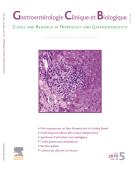The cholangiographic features of severe forms of ABCB4/MDR3 deficiency-associated cholangiopathy in adults - 26/07/10
 , L. Arrive d, O. Rosmorduc a, b, c
, L. Arrive d, O. Rosmorduc a, b, cSummary |
We previously reported the association of ABCB4/MDR3 gene variants with a peculiar form of cholelithiasis in European adults, currently referred to as the LPAC syndrome. ABCB4/MDR3 deficiency is also now thought to be related to some forms of hepatolithiasis in Japan. We herein report in eight patients a new phenotype associated with ABCB4 gene mutations, characterized by a typical LPAC symptomatic disease associated with large uni- or multifocal spindle-shaped dilations of the intrahepatic bile ducts without any bile duct stenosis, and filled of gallstones. We excluded from this series, the patients with minimal intrahepatic bile duct dilations, with bile duct stenosis, with focal or diffuse irregular bile ducts compatible with the diagnosis of sclerosing cholangitis, with bile duct dilations that did not contain stones or alternatively with stones in bile ducts without large dilations. The prevalence of this phenotype does not exceed 5 to 10% of the patients with LPAC syndrome. Importantly, the ABCB4/MDR3 mutations observed in this series did not differ from those observed in patients with LPAC syndrome with no or minimal intrahepatic bile duct dilations that could suggest a specific genetic background in this setting. This variant shows similar sensitivity to ursodeoxycholic acid and may be partly reversible under long-term therapy. In summary, we describe here a peculiar cholangiographic phenotype of the LPAC syndrome characterized by single-shaped large bile duct dilations filled with cholesterol or brown-pigment stones. This phenotype is not associated with a peculiar type of ABCB4 mutation.
Le texte complet de cet article est disponible en PDF.Plan
Vol 34 - N° 6-7
P. 380-387 - août 2010 Retour au numéroBienvenue sur EM-consulte, la référence des professionnels de santé.

